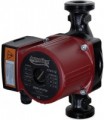Pump type
—
Centrifugal. As the name suggests, this type of pump uses centrifugal force. Their main element is the impeller installed in a round casing; the inlet is located on the axis of rotation of this wheel. During operation, due to the centrifugal force that occurs during the rotation of the wheel, the liquid is thrown from the centre to its edges and then enters the outlet pipe directed tangentially to the circle of rotation of the wheel. Centrifugal pumps are quite simple in design and inexpensive, while they are reliable and economical (due to high efficiency), and the fluid flow is continuous. At the same time, the performance of such units can drop with high resistance in the circuit.
—
Vortex. Vortex pumps are somewhat similar to centrifugal pumps: they also have a round casing and an impeller with blades. However, in such units, the inlet and outlet pipes of the working chamber are directed tangentially to the wheel, and the blades differ in design. The method of operation is also fundamentally different — it uses the vortices formed on the wheel blades. Vortex units are significantly superior to centrifugal units in terms of pressure, but they are sensitive to contamination — even small particles entering the impeller can cause damage, significantly reducing efficiency. And the efficiency of vortex pumps is low — 2-3 times lower than that of centrifugal pumps.
Inlet
The size of the inlet provided in the design of the pump. For plumbing threads (see Connection), the size is traditionally indicated in inches and fractions of an inch (for example, 1" or 3/4"), for flanges, the nominal diameter (DN) of the bore in millimetres is used — for example, DN65.
This parameter must match the dimensions of the mount on the pipe to which the pump is planned to be connected — otherwise, you will have to use adapters, which is not very convenient, and sometimes not recommended at all.
Outlet
The size of the outlet provided in the design of the pump. The value of this parameter is completely similar to the size of the inlet (see above).
Protection class
It is an indicator that determines the degree of protection of dangerous (moving and current-carrying) parts of the hardware of the pump from adverse effects, namely solid objects and water. Since pumps, by definition, are used for pumping liquids, and many of them can normally pass quite large particles, in this case, we are talking about protection against moisture and objects from outside.
The level of protection is usually indicated by a marking of the letters IP ("ingress protection") and two numbers, the first of which indicates protection against the effects of solid objects, and the second — against the ingress of water.
For the first digit, each value corresponds to the following protection values: 1 — protection against objects with a diameter of more than 50 mm (large body surfaces) 2 — against objects with a diameter of more than 12.5 mm (fingers, etc.) 3 — against objects more than 2.5 mm (most tools) 4 — against objects larger than 1 mm (virtually all tools, most wires) 5 — dust-proof (total protection against contact; the dust can enter, but does not affect the operation of the device) 6 — dust-proof (case with full dust protection and contact).
For the second digit: 1 — protection against vertically falling drops of water 2 — against drops of water with a deviation of up to 15 ° from the vertical axis of the device 3 — against drops of water with a deviation of up to 60 ° from the vertical axis of the device (rain) 4 — again...st splashes from any direction 5 — from jets from any direction 6 — from sea waves or strong water jets 7 — short-term immersion to a depth of up to 1 m (without the possibility of continuous operation in immersed mode) 8 — long-term immersion to a depth of more than 1 m (with the possibility of permanent operation) in immersed mode).
In some cases, one of the numbers may be replaced by the letter X — this means that the official certification for the corresponding parameter has not been carried out. In pumps, X is usually put in place of the first digit, because a high degree of moisture resistance in itself means a high degree of protection against solid contaminants. At the same time, for such models, an additional letter index can be provided, which describes the degree of protection against specific solid objects — for example, IPX2D. The letter D corresponds to the highest degree of stability, which does not allow the wire to be hit; the previous options A, B and C respectively mean protection from the hand, from the finger and a small tool like a screwdriver.

